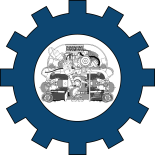Type 1: Difference between revisions
WestyMan1971 (talk | contribs) |
WestyMan1971 (talk | contribs) |
||
| (6 intermediate revisions by the same user not shown) | |||
| Line 127: | Line 127: | ||
Upon joining Volkswagen, Heinrich Nordhoff brought years of managerial, technical, and mass production experience to the young company. Nordhoff settled on a "one model" plan, where the product would retain a similar outward appearance, with minor changes made to improve performance and efficiency. Right away, he saw the need to expand the market. Though under British control, a strong export market had been created in a handful of European countries, Nordhoff realized that in order to survive, Volkswagen would have to break into the American market. At the time, The United States had the strongest post-war economy and most stable currency in the world. | Upon joining Volkswagen, Heinrich Nordhoff brought years of managerial, technical, and mass production experience to the young company. Nordhoff settled on a "one model" plan, where the product would retain a similar outward appearance, with minor changes made to improve performance and efficiency. Right away, he saw the need to expand the market. Though under British control, a strong export market had been created in a handful of European countries, Nordhoff realized that in order to survive, Volkswagen would have to break into the American market. At the time, The United States had the strongest post-war economy and most stable currency in the world. | ||
Norhoff recruited [[Ben Pon]], a highly successful Dutch importer, to introduce the Volkswagen to the American market. | Norhoff recruited [[Ben Pon]], a highly successful Dutch importer, to introduce the Volkswagen to the American market. Pon traveled to New York in 1949, bringing a Beetle along, to try and convince European Car dealers to sell the car. After a month of attempts, Pon was ultimately unsuccessful. He ended up selling the Beetle for just $800 in order to pay for his expenses. While a few VWs had been brought back to the United States by returning GIs, Norhoff was determined to break into the market. He traveled to the US himself later in 1949, but was no more successful, again selling only one car. | ||
In 1950, Max Hoffman took interest in Volkswagen. Hoffman was an established and successful American importer of European autos. Hoffman established a small American sales network which managed to sell 330 VWs in the first year. Many of the dealers who purchased Volkswagens did so in hope to establish a good report with Hoffman. They wished to acquire more exotic models from Jaguar or Porsche, and used the VW as their bargaining chip. By the end of 1953, 2,173 were registered in the United States. By comparison, VW exported over 70,000 cars in 1953 alone. Hoffman was quite disappointed with these figures and ended his relationship with VW by 1954. | |||
In 1952, six Beetles, a bare Type 1 chassis and six [[Type 2 Transporters]] were showcased at the Canadian National Exhibition. Reactions to the strange little car were mixed. Some were excited about a new, economical vehicle coming to market, but others were opposed to buying a German product only 7 years removed from World War II. The one thing that everyone could a agree on, is that it was "different." Despite this reaction, Volkswagen of Canada was established in a Toronto farmhouse later that year. VWoC sold 8 cars in their first year of operation. In 1953, VWoC president Werner Jansen and a small crew took a Beetle and a Transporter on a promotional trip. Interest in the vehicles grew as a result, and soon after an extensive dealer network was established across Canada. | |||
= Major changes by year = | = Major changes by year = | ||
===== 1938 ===== | ===== 1938 ===== | ||
44 hand-built VW38 pre-production models built. First split rear windshield. | *44 hand-built VW38 pre-production models built. First split rear windshield. | ||
===== 1939 ===== | ===== 1939 ===== | ||
50 hand-built VW39 pre-production models built. First use of stamping dies in production. First production KdF-Wagens built, approximately 200, before factory shifts to wartime production. | *50 hand-built VW39 pre-production models built. | ||
*First use of stamping dies in production. | |||
*First production KdF-Wagens built, approximately 200, before factory shifts to wartime production. | |||
===== 1940-1944 ===== | ===== 1940-1944 ===== | ||
''Chassis numbers 1-00,001 - 1-051,999'' | ''Chassis numbers 1-00,001 - 1-051,999'' | ||
*Limited production of KdF-Wagen. Estimated 840 built in this time frame. | |||
Limited production of KdF-Wagen. Estimated 840 built in this time frame. | |||
===== 1945 ===== | ===== 1945 ===== | ||
''Chassis numbers 1-052,0001-053,814'' | ''Chassis numbers 1-052,0001-053,814'' | ||
*Renamed Volkswagen Type 1, production restarted under British control. | |||
Renamed Volkswagen Type 1, production restarted under British control. | |||
===== 1946 ===== | ===== 1946 ===== | ||
''Chassis numbers 1-053,815 - 1-063,796'' | ''Chassis numbers 1-053,815 - 1-063,796'' | ||
*Pushrod tubes get compressible ends, replacing springs. | |||
*Fuel tank raised. | |||
*Grease nipple added on brake cables. | |||
*Tires increase in size from 4.5x16 to 5.0x16. | |||
===== 1947 ===== | ===== 1947 ===== | ||
Latest revision as of 18:50, 14 September 2024
| Beetle | |
|---|---|
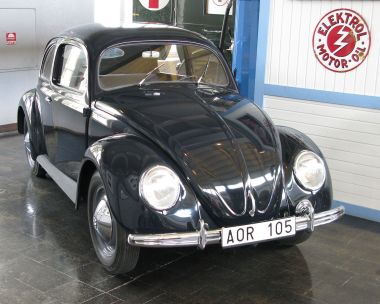 1949 Beetle Type 11 (Export Model) | |
| Overview | |
| Manufacturer | Volkswagen |
| Also called | |
| Production | 1938–2003: 21,529,464 built |
| Designer | Ferdinand Porsche |
| Variants | |
| Derivatives |
|
| Powertrain | |
| Engine | |
| Transmission |
|
| Dimensions | |
| Wheelbase | 2,400 mm (94.5 in) |
The Beetle—officially the Type 1, is an economy car that was manufactured and marketed by Volkswagen (VW) from 1938 until 2003.
It was designed by Ferdinand Porsche and features an air cooled rear-engine, two door coupe or cabriolet body-on-chassis design.
History
Josef Ganz's "Maikäfer" and the Standard Superior
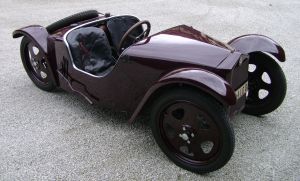
The idea of a "people's car" can traced as far back as 1923, when a young Jewish Hungarian engineering student named Josef Ganz began sketching concepts for a "car for the masses." Ganz's design featured a mid-mounted engine, independent suspension and a streamlined body.
Being a student, Ganz did not have the funding to produce a prototype of his design, but instead began submitting articles on automotive design for various publications. Shortly after completing his studies in 1927, Ganz was hired as editor-in-chief of Klein-Motor-Sport (later renamed Motor-Kritik), where he continued to write articles promoting progressive design and the creation of a car for the average citizen.
In 1929, Josef Ganz contacted motorcycle manufacturers Zündapp, Ardie and DKW with assistance to build a prototype of his concept. The first prototype, the Ardie-Ganz, was built at Ardie in 1930 and a second one was completed at Adler in 1931, which was nicknamed the Maikäfer (‘May-Beetle').
Production of the first car based on Josef Ganz's designs and patents began in 1933. The Standard Superior, built by Standard Fahrzeugfabrik, featured a body-on-tubular chassis, 2-stroke air cooled mid-engine, and independent suspension with rear swing-axles. This car was advertised as the German "Volkswagen," or "people's car," pre-dating the incorporation of Volkswagenwerk GmbH in 1937. Superior production ceased in 1935.
Due to the antisemitic policies of the Nazi Party, Ganz's influence on the development of the Beetle was largely forgotten and has often been left out of official Volkswagen history. His contribution is still widely debated to this day.
Ferdinand Porsche's prototypes
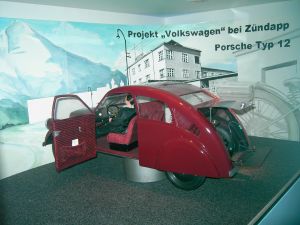
In 1931, Zündapp requested Austrian engineer Ferdinand Porsche design and build a prototype for an "everyman's automobile." This led to the development of three prototypes (two saloons and one coupe) known as the Porsche Type 12. These prototypes features a U-channel center beam chassis, leaf spring suspension, worm-gear steering and hydraulic drum brakes. The drivetrain consisted of a Zündapp-built five-cylinder radial engine (as opposed to Porsche's preferred flat-four engine) and a combined gearbox differential transmission joined by a wet single disc clutch. The Type 12 laid the basic design foundation for what would eventually become the Beetle.
In 1932, Porsche was contacted by NSU Motorenwerke to design and build a prototype automobile. NSU wished to return to manufacturing cars after a period of exclusively building motorcycles. While Zündapp has requested use of their radial engine, NSU placed no such restrictions and gave Porsche full control of development. This resulted in the construction of three prototypes, with two different body styles, called the Type 32. These prototypes featured the rear air-cooled flat-four engine, central tube frame, front axle, rear swing axle and torsion bar suspension that would become quite familiar to Volkswagen owners in the subsequent decades.
Adolf Hitler
In 1924, a young Adolf Hitler spent nine months in Landsberg Prison as a result of his Nazi Party's failed coup the year prior. While serving his sentence, Hitler read several books about Henry Ford's development of mass production techniques. Hitler showed great interest in automobiles, despite never having learned to drive. The future chancellor came to admire Ford and made it among his political ambitions to bring affordable transportation to the people of Germany in the same manner which Ford had done in the United States.
Upon Hitler's rise to power in 1933, the German auto industry was limited to luxury models, which few Germans could afford. Only one German out of 50 owned a car. The newly appointed chancellor began to form plans to utilize state resources to develop an affordable automobile. At the 1933 Berlin Auto Show, he viewed a presentation of the Standard Superior by Josef Ganz. Hitler was quite impressed with the revolutionary design and low price of the Superior. Ganz, however, was arrested by the Gestapo shortly thereafter on falsified charges of blackmailing the German automotive industry. Ganz was eventually released and quickly fled Germany.
In May 1934, at a meeting at Berlin's Kaiserhof Hotel, Hitler outlined his request for a basic vehicle that could transport two adults and three children at 100 km/h while not using more than 7 litres of fuel per 100 km. The engine had to be powerful enough for sustained cruising on Germany's Autobahn, which was under construction at the time. Parts needed to be widely available and quickly and affordably exchanged. The engine had to be air-cooled to avoid radiators freezing during the winter months. It's platform must be easily adapted to a variety of uses, including military applications. This "People's Car" was to be made available to citizens of Germany through a stamp booklet savings plan, for under 1000 Reichsmarks. (At the time, the average weekly income was around 32 Reichsmarks.)
By June 1934, Hitler had assigned the task of development to Ferdinand Porsche. A design team was quickly assembled which included future Porsche designers Erwin Komenda and Karl Rabe. By October 1935, two prototypes known as, a sedan (V1) and convertible (V2), were complete and ready for testing. By 1936, three more prototypes (V3) were finished. These cars were designated Type 60 and built by hand in Porsche's Stuttgart workshop.
Hitler was impressed with the V3 prototype at the Berlin Auto Show and immediately ordered that it enter production. The Reichsverband der Deutsche Automobilindustrie, a special interest group representing German automakers, immediately pushed back against further development, seeing the low cost of the car as a threat to their business. This in turn caused Hitler to declare the project a wholly state-run enterprise of the national labor union, Deutsche Arbeitsfront.
A further thirty development models, known as V30, were produced for Porsche by Daimler-Benz. These vehicles underwent demanding tests through a variety of terrain and environmental conditions. Overall, these cars were subjected to a combined 1.8 million miles over the course of 1937. Though lacking a rear window, all V30s shared the distinctive round shape and the air-cooled, rear-mounted engine of final production models.
The final design added a split rear windshield. In 1938, 44 pre-production models known as the VW38 were built by hand in Stuttgart. The very first convertible model from this batch (chassis 38/31) was presented to Hitler as a gift. Fifty more cars followed in 1939 (VW39), and though still hand-built, some parts utilized the new stamping dies built for production.
The KdF Wagen and a new factory
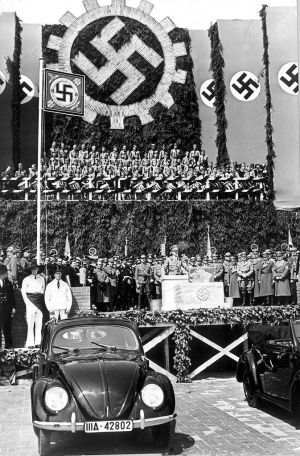
By 1937, it was decided that a new factory was needed for production of the "people's car." Land was seized in Northern Germany, along the banks of the Mitteland Canal in the village of Fallersleben. Construction of the new factory began in February 1938.
On May 26, 1938, a cornerstone-laying ceremony was held at the site of the new factory with typical Nazi-party fanfare and propaganda photo-ops. In the speech given by Adolph Hitler, he announced the new automobile to be built on the site will be named "Kraft-durch-Freude-Wagen" ("Strength Through Joy Car," abbreviated to KdF-Wagen) after the leisure organization operated by Deutsche Arbeitsfront. He also outlined his plan for construction of a grand factory city known as "Stadt des KdF-Wagens bei Fallersleben" ("City of the Strength Through Joy car at Fallersleben") to be built on the southern side of the canal.
Production of the KdF Wagen was scheduled to begin in the Autumn of 1939. Nazi propaganda claimed the new factory was expected to produce 500,000 vehicles per year, all for the benefit of the German people. However, only about 200 vehicles were produced prior to the outbreak of war. Most of these early production vehicles were given to Nazi Party officials and few, if any, citizens received their car through the stamp-booklet savings plan.
Wartime production
On September 1, 1939, Nazi Germany invaded Poland. Two days later, France and Britain declared war on Germany, signaling the start of World War II.
Almost immediately, the factory at KdF-Stadt shifted to wartime production. The primary vehicles produced during this time were the Porsche-designed Type 82 Kübelwagen and Type 166 Schwimmwagen. A handful of light vehicles based on the KdF-Wagen were constructed, such as the Type 82E Kommandeurswagen. The manufacturing resources of the factory were also used to produce other military equipment including stoves, aircraft parts and assemblies for the V1 flying bomb. A very limited number of civilian KdF-Wagens were built during the war, which were primarily handed to high-ranking Nazi Party members.
Production at KdF-Stadt was halted in 1944 after the factory sustained significant damage due to Allied bombing. Much of the critical equipment was moved into bunkers, with expectation that production would resume after hostilities ceased.
Due to gasoline shortages in the late stages of the war, a small number of vehicles were converted to utilize wood-burning gas generators. These became known as "Holzbrenner" Beetles.
In early 1945, the tide of war had turned. American troops were advancing deeper into Germany and over two thirds of the factory lay in ruin. Some workers, many of whom were foreign forced laborers, began destroying as much as they could of what was left.
Allied occupation
KdF-Stadt was captured by US troops on April 11, 1945. Over 7,700 forced laborers were liberated from the factory. On May 25, 1945, the city was renamed Wolfsburg, after the nearby Wolfsburg Castle. The Americans occupied Wolfsburg until June 1945, at which time it became part of the British Occupation Zone.
The British intended to dismantle the factory and ship all useable assets to Britain under the Morgenthau Plan. However, no British automaker was interested in the factory. Sir William Rootes, head of the British Rootes Group, told Hirst the project would fail within two years, is quoted as saying the car "is quite unattractive to the average motorcar buyer, is too ugly and too noisy. If you think you're going to build cars in this place, you're a bloody fool."
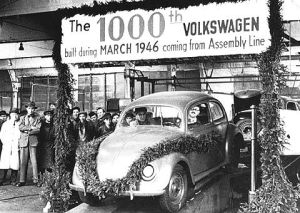
Responsibility for the city and the factory then fell to a division of the Royal Electrical and Mechanical Engineers commanded by Major Ivan Hirst. At the time, the bombed-out factory was being utilized as a repair shop for Allied military and transport vehicles. Hirst soon discovered that much of the original tooling and parts remained undamaged. His team assembled a few complete vehicles from existing parts and saw the potential in the quirky little car. Realizing that occupation forces required a cheap and reliable form of transportation during Germany's reconstruction, Hirst saw an opportunity. The car was presented to the British Military, who promptly placed an order for 20,000 vehicles. Two weeks later, the order was doubled to 40,000.
Hirst quickly grew the workforce from the remaining 450 post-war workers to over 6,500 employees. At this time, the car reverted to it's original name, "Volkswagen" (People's Car) and the model was designated the "Type 1." The first production Type 1 rolled off the assembly line on December 27, 1945. By March 1946, the Wolfsburg plant was producing 1,000 cars per month, painted army green for the British military. Early production numbers were limited by rationing and a shortage of raw materials, such as steel, batteries, textiles, and glass. Early Beetle roof sections were fashioned out of two pieces of steel, due to larger sheets being unavailable. Hirst convinced the British government to allocate the necessary materials, as the operation of the factory stimulated economic growth and increased employment during post-war reconstruction.
1947 signaled a transition into building a civilian version of the Type 1. For the first time, chrome bumpers, hubcaps and body trim were fitted. Engine displacement was increased to 1131cc and had an output of 25hp. Models destined for export markets were designated and marketed as the Type 11. Civilian output reached 9,000 units in 1947, which increased to almost 20,000 in 1948.
In March 1948, the British offered the company to Ford, free of charge. Henry Ford II and Ford chairman Ernest Breech travelled to West Germany to tour the factory. When Ford asked Breech for his opinion, Breech said, "Mr. Ford, I don't think what we're being offered here is worth a damn!"
Returning Volkswagen to German control
After the British-led restart of production and failing to find a buyer for the company, Hirst began to look for a successor to return day-to-day operations back to the Germans. Former Opel director Heinrich Nordhoff was offered a position as manager. Despite being highly critical of the Volkswagen's unconventional engineering in the past, Nordhoff had few other opportunities. Though he was never a member of the Nazi Party, he had been barred from work in the American sector due to his position at the Opel factory building German military vehicles. Nordhoff accepted and took control of the Wolfsburg plant on January 1, 1948.
Under Nordhoff's leadership, the British Military Government slowly took a backseat to operations. On October 8, 1949, ownership of Volkswagenwerk GmbH was transferred to the newly-formed West German government.
Expansion and export
Upon joining Volkswagen, Heinrich Nordhoff brought years of managerial, technical, and mass production experience to the young company. Nordhoff settled on a "one model" plan, where the product would retain a similar outward appearance, with minor changes made to improve performance and efficiency. Right away, he saw the need to expand the market. Though under British control, a strong export market had been created in a handful of European countries, Nordhoff realized that in order to survive, Volkswagen would have to break into the American market. At the time, The United States had the strongest post-war economy and most stable currency in the world.
Norhoff recruited Ben Pon, a highly successful Dutch importer, to introduce the Volkswagen to the American market. Pon traveled to New York in 1949, bringing a Beetle along, to try and convince European Car dealers to sell the car. After a month of attempts, Pon was ultimately unsuccessful. He ended up selling the Beetle for just $800 in order to pay for his expenses. While a few VWs had been brought back to the United States by returning GIs, Norhoff was determined to break into the market. He traveled to the US himself later in 1949, but was no more successful, again selling only one car.
In 1950, Max Hoffman took interest in Volkswagen. Hoffman was an established and successful American importer of European autos. Hoffman established a small American sales network which managed to sell 330 VWs in the first year. Many of the dealers who purchased Volkswagens did so in hope to establish a good report with Hoffman. They wished to acquire more exotic models from Jaguar or Porsche, and used the VW as their bargaining chip. By the end of 1953, 2,173 were registered in the United States. By comparison, VW exported over 70,000 cars in 1953 alone. Hoffman was quite disappointed with these figures and ended his relationship with VW by 1954.
In 1952, six Beetles, a bare Type 1 chassis and six Type 2 Transporters were showcased at the Canadian National Exhibition. Reactions to the strange little car were mixed. Some were excited about a new, economical vehicle coming to market, but others were opposed to buying a German product only 7 years removed from World War II. The one thing that everyone could a agree on, is that it was "different." Despite this reaction, Volkswagen of Canada was established in a Toronto farmhouse later that year. VWoC sold 8 cars in their first year of operation. In 1953, VWoC president Werner Jansen and a small crew took a Beetle and a Transporter on a promotional trip. Interest in the vehicles grew as a result, and soon after an extensive dealer network was established across Canada.
Major changes by year
1938
- 44 hand-built VW38 pre-production models built. First split rear windshield.
1939
- 50 hand-built VW39 pre-production models built.
- First use of stamping dies in production.
- First production KdF-Wagens built, approximately 200, before factory shifts to wartime production.
1940-1944
Chassis numbers 1-00,001 - 1-051,999
- Limited production of KdF-Wagen. Estimated 840 built in this time frame.
1945
Chassis numbers 1-052,0001-053,814
- Renamed Volkswagen Type 1, production restarted under British control.
1946
Chassis numbers 1-053,815 - 1-063,796
- Pushrod tubes get compressible ends, replacing springs.
- Fuel tank raised.
- Grease nipple added on brake cables.
- Tires increase in size from 4.5x16 to 5.0x16.
